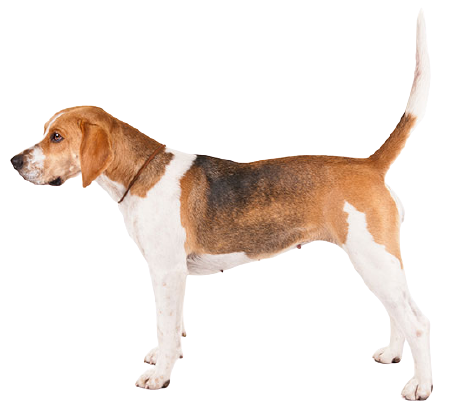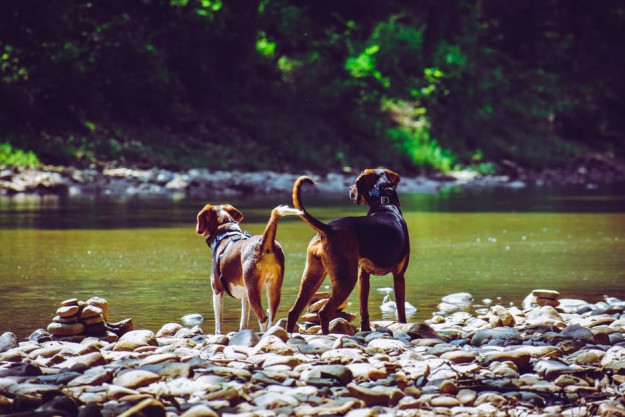
Harrier
USD $300-$400 Price Avg.
Hunting Dogs
Group
Purebred
Breed Type
Medium
Size
10-12 years
Lifespan
Breed Information
| Group | Hunting Dogs |
|---|---|
| Popularity/Rank | 183 |
| Origin | United Kingdom |
| Other Names | Harehound |
| Breed Type | Purebred |
| Price (Avg.) |
USD $300-$400
How much does a Harrier cost? According to a rough estimate, you will spend between $300 to $400 on your Harrier if you purchase it from a reputable breeder. If you select a dog with exceptional bloodlines, the price may be higher. The price might even be higher if the dog has already been trained. You'll usually pay less if you get a Harrier from a shelter. |
| Size | Medium |
| Weight | 40-60 pounds (18-27 kg) |
| Height | 19-21 inches (48-50 cm) |
| Lifespan | 10-12 years |
| Recognized by |
AKC, FCI
The American Kennel Club in 1885 as a Hound breed. And FCI in the Scent hounds and related breeds group, in the Scent hounds section. |
| Purpose | trailing game |
| Date of Origin | 1066 AD |
| Ancestry | Scenthound |
Appearance & Maintenance
| Coat | Shiny, Thick |
|---|---|
| Coat Colors | Black, Lemon, Red, Tan, White |
| Grooming Level | |
| Shedding Level | |
| Eye Color Possibilities | Amber, Brown, Hazel |
| Nose Color Possibilities | Black |
| Coat Color Possibilities | Black, Brindle, Brown, Cream, Fawn, Gray, Pied, Red, Sable, White |
| Coat Length | Small |
| Coat Density | Dense |
| Coat Texture | Straight |
| Recommended Brushes | Nail Clipper, Pin Brush, Slicker Brush |
| Brushing Frequency | Weekly |
Breed Characteristics
| Temperament | Active, Cheerful, Friendly, Outgoing, Sweet, Tempered, Tolerant |
|---|---|
| Intelligent | |
| Trainability | |
| Playfulness | |
| Sensitivity Level | |
| Affection Level | |
| Social Interaction Required | |
| Barking | |
| Watchdog Ability | |
| Territorial | |
| Biting Force | Low |
| Mouthiness | |
| Impulse to Wander or Roam | |
| Prey Drive | |
| Adaptability | |
| Tolerates Being Left Alone | |
| Fighting Dog | Not really |
Good & Friendly with
| Apartment Life Friendly | |
|---|---|
| Stranger Friendly | |
| Kid-Friendly | |
| Cat Friendly | |
| Dog Friendly | |
| Office Friendly | Yes |
| Senior Citizens Friendly | |
| Pet Friendly | |
| Friendly with First Time Owners | Yes |
| Service Dog | Not really |
| Therapy Dog | Not really |
| Detection, Sniffer or Security Dog | Not really |
| Search and Rescue Dog (SAR) | Not really |
| Boat Dog | Not really |
| Cart Pulling or Drafting Dog | Not really |
Health Elements
| Health Issues | |
|---|---|
| Health Problems | Ear Infections, Eye Problems, Obesity |
| Hypoallergenic | No |
| Energy Level | |
| Exercise Required | |
| Sleeping Required | |
| Weight Gain Potential | |
| Weather & Climate | Tolerates warm and cold weather. |
| Stinkiness | Medium |
| Drooling tendency | |
| Activity Level | Moderate |
| Rec. Walk Mileage Per Week | 12 miles |
| Minutes of Activity Per Day | 90 minutes |
Food & Costing
| Avg. Daily Food | 2 to 2.5 cup of high-quality dry food a day, divided into two meals. |
|---|---|
| Cups Per Day | 2.5 cups |
| Daily Cost | $1.75 - $2.25 |
| Monthly Cost | $60.00 - $67.50 |
Reproducibility
| Gestation Duration | 60-64 days |
|---|---|
| How often can the Harrier have a litter? | Once a year. |
| Litter Size | 5-7 puppies (Once a year.) |
Description
The Harrier is a medium-sized hound dog that has been around for centuries. It is a descendant of the English Foxhound and was originally bred to hunt hares. The Harrier has a strong, muscular body with long legs and an alert expression. Its coat is short and dense, usually in shades of tan, black, or white.
The average lifespan of the Harrier is between 10 and 12 years. They typically weigh between 40 and 60 pounds when fully grown, with males being slightly larger than females. The colors of the Harrier can vary from white to black or tan with some having brindle markings as well.
The personality of the Harrier is friendly and outgoing but also independent and determined. They are loyal to their owners but can be stubborn at times if not properly trained from an early age. They are also very active dogs that need plenty of exercise in order to stay healthy and happy.
Harriers are generally friendly towards other dogs, children, cats, and other animals if they have been socialized properly from an early age. However, they may be wary of strangers due to their natural instinct as hunting dogs so it’s important to introduce them slowly into new situations or environments where there may be unfamiliar people or animals present.
The temperament of the Harrier is alert yet gentle which makes them great family pets as well as watchdogs since they will bark when something unusual happens in their environment but won’t become aggressive unless provoked by another animal or person.
When it comes to health issues, the Harrier is generally quite healthy although some may suffer from hip dysplasia which can cause lameness in one or both hind legs if left untreated for too long so regular checkups with your vet are recommended for this breed just like any other breed of dog out there!
Harriers have a high level of adaptability which makes them great companions for those who live in apartments since they don’t require much space nor do they need excessive amounts of exercise like some larger breeds do; however it’s still important that you provide your pet with plenty opportunities for physical activity such as walks around the neighborhood or trips to nearby parks so that he/she can get enough exercise on a daily basis!
Overall, owning a Harrier dog can be very rewarding since these dogs make wonderful companions due to their loyal nature combined with their intelligence which allows them to learn quickly when given proper training; plus they don’t require too much maintenance either making them ideal pets for those who don’t have much time on their hands!
History
The Harrier is a breed of dog that was once on the brink of extinction. The breed is thought to have originated in England, and was used for hunting hare. The Harrier was almost wiped out during World War II, but was saved by a few dedicated breeders. The breed has since become popular in the United States and other countries.
The Harrier is a descendant of the English Foxhound. The breed was developed in the late 1800s, and was used for hunting hare. The Harrier was almost wiped out during World War II, but was saved by a few dedicated breeders. The breed has since become popular in the United States and other countries.
The Harrier is recognized as a distinct breed by the American Kennel Club and other kennel clubs around the world. The breed is still used for hunting in some parts of the world, but is also kept as a pet.




